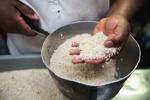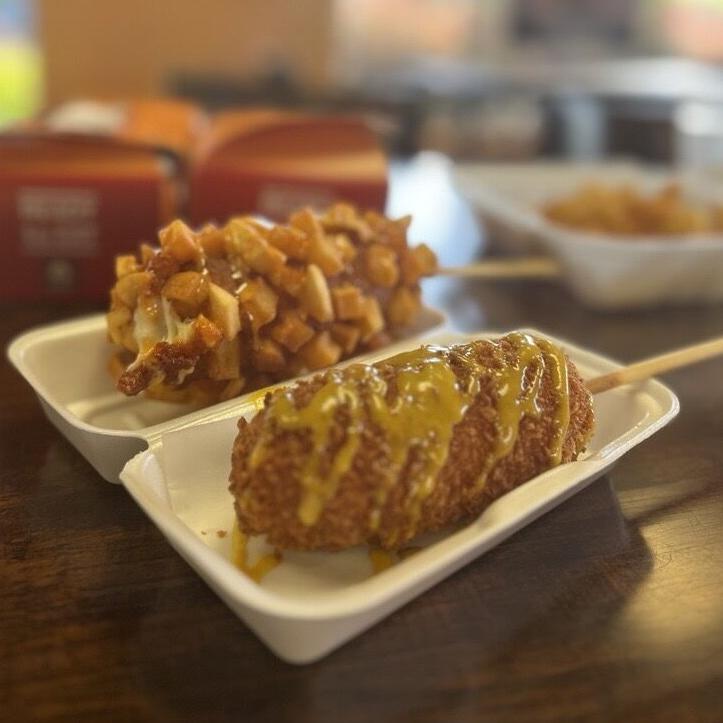COLUMBIA — When staff at 92 Chicken South Carolina, a Korean fried chicken restaurant on Decker Boulevard, noticed their Korean corn dogs becoming a huge hit on social media around the world, they knew it would be a hit.
“We know that Americans like fries, cheese and sausage,” owner David Chang told the Free Times in a translated interview. “They’re used to those things, and they’re comfort foods.”
The original Korean corn dog is just one of many Korean food trends that Chang and his team have brought to South Carolina. As of press time, 92 Chicken is the only restaurant in Columbia offering four different versions of the beef-and-cheese Korean corn dog, as well as the city’s first homemade buldak (Korean “fire chicken” recipe). These menu items are more than just eye-catching stunt food; for Columbia, they’re a glimpse into Korea’s contemporary culinary world and the trends that are dominating global foodie culture.
Korean corn dogs bear little resemblance to the cornmeal-crusted hot dog South Carolinians imagine: These versions can be stuffed with any combination of cheese, beef or fish sausage, rolled in potato or sugar and even made with squid ink or rice flour in the dough.

92 Chicken’s fries and mozzarella corn dog with sriracha mayo sauce (left) and half and half corn dog with honey mustard sauce (right).
Jane Godiner jgodiner@postandcourier.com
At 92 Chicken, you can choose from beef sausage, mozzarella sticks or a “half and half” combination. Your choice of filling is encased in a slightly sweet and incredibly fluffy corn and flour dough that is leavened in-house. For a starchy crunch, choose the mozzarella sticks wrapped around chopped french fries.
Chang said developing the recipe was no easy task: from start to finish, it took six months of “trial and error” for the team of food experts to get the hang of creating a porous, bread-like dough.
“Fermenting the breading played a very important and crucial role in processing the corn dog,” Chang said, “which is why it took so long.”

Colombia’s unique “fire noodles” challenge — with a twist
While the team was working on the dough, Jeong Kim, a food specialist at 92 Chicken South Carolina, noticed that Korean brand Samyang’s Buldak instant ramen was starting to gain popularity on social media in the US. Across the country, influencers were sampling the noodles, which are doused in a sauce that’s two to three times more Scoville hotness than a jalapeño, on camera and reacting live to millions of viewers.
Kim believed it was popular enough to consider introducing it to Columbia.
Following international controversy over Buldak Sauce’s extreme heat, Kim led the 92 Chicken kitchen to create a sauce from scratch that was only “80 percent spicier” than the original. Buldak Sauce contains significantly higher concentrations of pure capsaicin, the chemical responsible for chili peppers’ mouth-tingling heat, but the 92 Chicken team wanted to change the way it was sourced.
“We decided not to add capsaicin to maintain the freshness and balance the sweet and spicy flavors,” Chang says. “We’re not adding capsaicin directly, but we’re trying to mimic it.”
Another challenge in formulating the sauce was accurately recreating the taste of Buldak Sauce using chili peppers from different parts of East Asia. As Kim experimented with different recipes, he realized that using just one type of chili pepper would not be enough.

92 Chicken’s Buldak Chicken (left) and Original Fried Chicken (right).
Jane Godiner jgodiner@postandcourier.com
“The Korean chilies we used weren’t that hot, but the Vietnamese dried chilies were a little more bitter than we expected,” Kim told Free Times in a translated interview. “So we thought, ‘The Korean chilies are quite sweet, so if we mix them together, maybe it will create a good balance.'”
The final 92 Chicken Buldak Chicken Recipe is a warm, gradually increasing spiciness with a citrus sweetness and slight sourness that doesn’t really hit you until you’ve eaten a few pieces.Compared to Samyang brand Buldak, it’s a little milder in spiciness, but you’ll notice that the spiciness lasts for a shorter period of time.
92 While the chicken sauce itself doesn’t have the umami components of chicken-flavored Samyang Sauce, the Original Fried Chicken is a flavorful sauce that is perfect for homemade Buldak.
92 Chicken launched its Buldak Chicken and Korean Corn Dog line in June. Faced with the challenge of creating a menu that would appeal to South Carolina residents, the company started by offering a 10 percent discount on Buldak Chicken orders and promoting the corn dogs.
“We had to come up with certain phrases to help them understand the taste,” said Yoon Choi, who works at the ordering counter. “I wasn’t always trying to convince everyone, but I tried to attract them and teach them the Korean style of taste.”

But Choi said not all customers needed her explanation.
“I was kind of surprised that they actually knew,” she said. “Some of them even asked for sugar in their corn dogs.”
Choi believes a number of cultural factors contribute to the growing awareness among his customer base.
“Everybody knows it from K-pop,” she says. “A lot of people say, ‘I was stationed in Korea, so I tried it there. Does it taste similar?'”

David Chang, owner of 92 Chicken on Decker Boulevard in Columbia, stands at the counter of his restaurant.
Jane Godiner jgodiner@postandcourier.com
As for Buldak Chicken, Chang reported that its sales are currently in the “middle ground” and that it is currently the sixth best-selling flavor out of all 21 flavors. Reviews are more divided.
“There are two kinds of people,” Choi said. “Some people say it’s very spicy, and some people say it’s not spicy at all.”
“That made me angry,” Chan added. “I said, ‘Next time you come, I’ll make it a little harder for you.'”
If you’re looking to spice up your Buldak Chicken order, feel free to ask: Chang and Choi say they’re open to tweaking the recipe to suit each customer’s tastes, especially in the early stages of the product’s launch.
For now, Chang is happy to bring his popular Korean cuisine to Soda City.
“We’re in remote South Carolina, where there aren’t many Asians,” Chang said. “We’re promoting Korean culture.”


